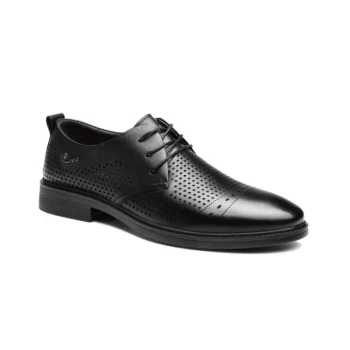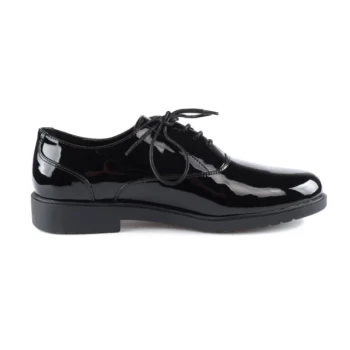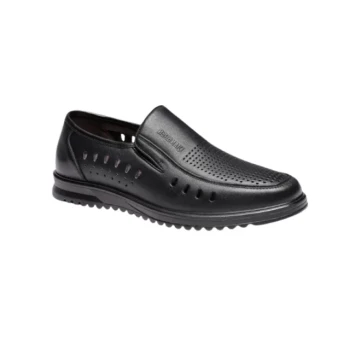At its core, the lining of a dress shoe is the material that makes direct contact with your foot, covering the entire interior of the shoe. It serves as the critical interface between you and the shoe's outer structure, and its quality is a non-negotiable factor in determining overall comfort, foot health, and the shoe's lifespan.
The lining is a hidden hallmark of a well-made dress shoe. While the exterior determines the style, the interior lining dictates the shoe's comfort, breathability, and ability to maintain its shape over time.
The Role of the Lining: An Unseen Workhorse
A shoe's lining performs several crucial functions that go far beyond simple aesthetics. It is an active component that directly impacts your experience wearing the shoe.
Enhancing Comfort and Fit
A quality lining, typically made of soft leather, provides a smooth surface that prevents rubbing and chafing against your skin. This drastically reduces the risk of blisters and discomfort, especially during the break-in period.
Managing Moisture and Breathability
Your feet sweat, and a good lining is essential for managing that moisture. Porous materials like leather excel at wicking away perspiration, keeping your feet dry and promoting a healthy internal environment. This is the primary defense against odor and fungal growth.
Preserving the Shoe's Structure
The lining adds a crucial layer of reinforcement to the shoe's upper. It helps the outer leather maintain its intended shape, preventing it from stretching or deforming excessively with prolonged wear.
Common Lining Materials: What to Look For
The material used for the lining is a clear indicator of the shoe's overall quality and intended performance.
Full Leather Lining (The Gold Standard)
A full leather lining is the hallmark of a premium dress shoe. It is exceptionally breathable, absorbent, and durable. Over time, it will mold to the unique shape of your foot, creating a customized and supremely comfortable fit.
Fabric and Synthetic Linings
Many shoes utilize fabric or synthetic materials for their lining to reduce costs. While modern synthetics can be engineered for breathability, they typically do not offer the same level of moisture absorption or long-term durability as genuine leather.
Partial and Unlined Shoes
Some styles, particularly summer loafers, may be partially lined or completely unlined. This construction maximizes breathability and flexibility for casual wear but offers less structural support and a different comfort profile.
Understanding the Trade-offs
Choosing a shoe involves balancing cost, comfort, and longevity, and the lining is central to this equation.
Cost vs. Long-Term Value
Shoes with full leather linings are more expensive upfront. However, their superior durability, comfort, and ability to be resoled mean they often represent a better long-term investment than less expensive shoes with synthetic interiors that degrade more quickly.
Breathability is Non-Negotiable
A lining that doesn't breathe effectively traps heat and moisture. This not only leads to discomfort and odor but can also accelerate the breakdown of the shoe's internal components, including the glues and insole.
How Lining Works with Other Components
The lining doesn't work in isolation. It functions as part of a system with the insole (the footbed) and the upper (the outer leather). A premium leather lining complements a quality leather upper, creating a cohesive structure that provides both support and flexibility.
Making the Right Choice for Your Goal
When inspecting a potential pair of dress shoes, always feel the interior to assess the lining material and its finish.
- If your primary focus is maximum comfort and longevity for daily wear: Insist on a full-grain leather lining, as nothing else provides the same combination of breathability and durability.
- If your primary focus is a budget-friendly option for infrequent events: A shoe with a quality, well-finished fabric or synthetic lining can be a perfectly acceptable choice.
- If your primary focus is a lightweight, flexible shoe for warm weather: A partially lined or unlined loafer can provide excellent breathability, but accept the trade-off in structural support.
Ultimately, paying attention to this hidden detail is the key to investing in a shoe that not only looks good but feels exceptional to wear.
Summary Table:
| Lining Material | Key Features | Best For |
|---|---|---|
| Full Leather | Superior breathability, molds to your foot, highly durable | Maximum comfort & long-term investment |
| Fabric/Synthetic | Cost-effective, varying breathability | Budget-friendly, infrequent wear |
| Partial/Unlined | Maximum breathability, lightweight, flexible | Warm weather, casual styles |
As a leading manufacturer, 3515 produces premium footwear for distributors, brand owners, and bulk clients. We specialize in crafting shoes with high-quality linings that ensure exceptional comfort and durability for your customers.
Ready to elevate your footwear line? Contact us today to discuss your manufacturing needs and discover how our comprehensive range of shoes and boots can add value to your business.
Related Products
- Wholesale Leather Derby Shoes Manufacturer | Customizable Business & Dress Footwear
- Wholesale Leather Business Casual Shoes with Dial Closure - Manufacturer of Comfort Dress Sneakers
- Wholesale Comfortable Business Casual Shoes Custom Manufacturing
- Wholesale Breathable Perforated Leather Derby Dress Shoes for Custom Brands
- Wholesale Comfort Leather Business Shoes with Dial Lacing System
People Also Ask
- Why are quality shoes important for overall appearance? The Anchor to a Polished Impression
- What are the benefits of calf leather for dress shoes? Unmatched Elegance & Comfort
- How does the welt stitching differ between Oxfords and Derbies? A Guide to Shoe Formality
- What should be known about genuine leather for shoes? Don't Be Misled by the Label
- What are some common styles of dress shoes? Master the Language of Formality



















